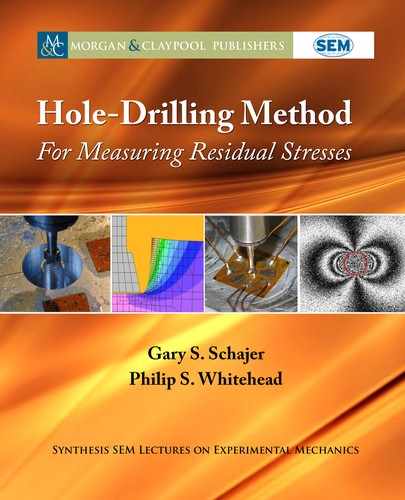
1.3. SOURCES OF RESIDUAL STRESSES 5
more effectively. In such cases the residual stresses may be deliberately created, for example in
pre-stressed concrete, bolted and riveted connections, and shrink-fitted components.
Conversely, in many cases the residual stresses that exist in redundant structures can be-
come large and damaging. Assembly misfits and support settlement commonly cause large resid-
ual stresses in structures such as bridges and buildings. Environmental temperature changes can
similarly create substantial residual stresses. A well-known example of this effect are “sun-kinks,”
which can occur in continuously welded railway rails in hot weather. e longitudinal constraint
imposed by the continuous welding together with the latent thermal expansion due to the hot
weather creates very large compressive axial forces. If the ballast of the railbed does not provide
sufficient lateral constraint, the compressive axial forces cause the rails to buckle, sometimes
quite dramatically. Figure 1.4 shows some examples of rail buckling recorded by the US De-
partment of Transportation. ey reported an average of 38 train derailments per year in the
United States due to track buckling during the period 1992–2002.
Figure 1.4: ermal buckling of railway rails, also called “sun-kinks” (photo courtesy of Volpe,
e National Transportation Systems Center, USDOT).
High structural redundancy increases the susceptibility of assembled structures to the de-
velopment of residual stresses. us, engineering designs often include features to reduce struc-
tural constraint, such as gaps between railway rails (now a deprecated choice because of the
resulting increase in vibration and noise), thermal expansion joints in pipelines and shear and
pin supports in bridges. Figure 1.5 shows examples of constraint reduction features in large
structures.

6 1. NATURE AND SOURCE OF RESIDUAL STRESSES
(a) (b) (c)
Figure 1.5: Constraint reduction features to reduce structural residual stresses. (a) U-bend in a
hot-water distribution pipe, (b) shear supports in a concrete railway bridge, and (c) pinned joints
in a steel road bridge.
1.3.2 NON-UNIFORM DIMENSIONAL VARIATIONS DUE TO THERMAL
EFFECTS
Local dimensional misfits within a material are commonly created by thermal processes during
the material manufacture. Non-uniform cooling from a molten state to a solid state, such as
occurs in the production of thermally toughened glass, Figures 1.1 and 1.2, is an example. In
this case, the temperature non-uniformity is deliberately introduced to create desired residual
stresses. However, in many cases the stresses are undesirable, and need to be controlled, typi-
cally by using slow cooling rates or by holding at a high temperature to allow the material to
equilibrate. If not well controlled, very large stresses of this kind can be developed in castings,
leading to dimensional instability during subsequent use or, in extreme cases, cracking of the
cast ingot, as illustrated in Figure 1.6.
Welding is also well-known to produce very large residual stresses, reaching up to the ten-
sile yield stress longitudinally within the weld. ese stresses produce the type of dimensional
distortion schematically illustrated in Figure 1.7a. Analogous lateral effects produce the distor-
tion illustrated in Figure 1.7b. ese effects can be reduced by control of welding technique,
fixturing and stress relief of the finished weld by post annealing, shot peening and vibratory
stress relief.
e formation of residual stresses in quenched components has several similarities to the
process described for the solidification of a casting. For a quenched component, the starting
temperature for the process is below the fusion temperature but is sufficiently high such that
the yield strength of the component material is significantly smaller than the strength at room
temperature. As the component is immersed in the quenching medium, usually water, oil or air,
the temperature of the component skin reduces rapidly and the yield strength of this material
increases. As the quench proceeds, the thickness of the cooler skin increases, while the reduction

1.3. SOURCES OF RESIDUAL STRESSES 7
Figure 1.6: Cracking of a cast aluminum ingot due to excessive residual stresses (photo courtesy
of Mark Newborn, Alcoa).
(a)
(b)
Figure 1.7: Geometrical distortions caused by welding residual stresses. (a) Plan view show-
ing in-plane effects and (b) side view showing out-of-plane effects (adapted from Wizard191,
Wikimedia Commons).
..................Content has been hidden....................
You can't read the all page of ebook, please click here login for view all page.
